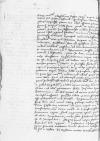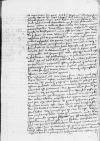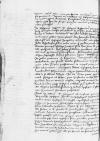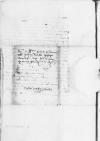Letter #2863
Cornelis DE SCHEPPER to Ioannes DANTISCUSLondon, 1545-09-01
English register:
De Schepper wonders whether Dantiscus received his letter, sent recently from Hardewijk. He informs him that a chronic illness thwarted Maximiliaan van Egmond's plans to write to Dantiscus.
De Schepper returned to Brussels on 30 July with the Queen [Mary of Hungary]. Hardly had he put his affairs in order and brought his wife [Elisabeth Donche] over when the Emperor [Charles V] sent him to England to persuade the King [Henry VIII] to sign a peace treaty with the King of France [Francis I]. He arrived in London on 18 August. He compares the size of the English and French fleets. He describes his mission. To obtain an audience he had to travel from London to Guildford. He does not expect a favourable outcome to his mission because the King of England has decided that the peace initiative should come from the King of France as the aggressor, who additionally incited the Scots to war. The Emperor sent an envoy to the King of France on the same matter. De Schepper does not know the results of that mission.
De Schepper informs Dantiscus that after long years of service, Eustace Chapuys, whom Dantiscus knew in Granada, has been replaced in his capacity as permanent imperial ambassador in England by Francis van der Dilft, a friend of Erasmus', whom Dantiscus perhaps also knew in Spain. The ailing Chapuys is resting in Louvain, devoting himself to literary studies.
De Schepper supposes that Dantiscus might also know Cuthbert Tunstall, the current bishop of Durham, who lives a pious life far from the court. Dantiscus should remember Stephen Gardiner, Bishop of Winchester, from Bologna. He recently demonstrated in-depth knowledge of the Bible when fighting against Martin Bucer. Thanks to his influence over the King of England, the heresies of Zwingli and Oecolampadius and also – above all – Anabaptism have no chance to spread in the country. De Schepper expresses the view that the aim of these heresies is to overthrow proper social order in the state; however, even when equality manages to replace the authority of power, it does not last. Church ceremonies in England have not changed, except that the conditions of taking Communion have been made stricter. Meanwhile, monasteries have been dissolved, while the Pope is no more important than a bishop. Prayers during processions are said in the national language. De Schepper thinks that the only reason some of the clergy are not favouring heresy openly is out of fear of the King.
De Schepper hopes the Scots will be willing to make peace with England after their own military defeats and those of the French, who incited them to war. De Schepper witnessed the arrival of envoys from Scotland but does not know from which part of the country. He explains the political division of Scotland into three parts. One of them is ruled by the Dowager Queen [Mary of Guise] with the help of James Hamilton, and another by the Cardinal of St. Andrews [David Beaton], while the third is under the King of England's rule.
De Schepper asks for news about the political situation in Poland. The death of the young Queen [Elisabeth of Austria] has given rise to all kinds of rumours and speculation in the Low Countries regarding the approach of great changes. In De Schepper's view, Poland flourished as long as it had no ambition to extend its borders. He hopes the Kingdom of Poland's elite, among whom he counts Dantiscus, will show sense, and so refuses to believe the rumours for now.
De Schepper reports that the Emperor is staying in Brabant. All matters from the Diet in Worms have been deferred to early next year. De Schepper hopes the year brings no other, more dangerous, kind of assembly. Because he left The Low Countries before the Emperor's arrival, he does not know what might be expected from the German princes at the next Diet.
News has come from Spain that the wife of Prince Philip [Maria Manuela of Portugal] died in childbirth. Her son [Carlos of Asturias] is fine. Spanish affairs are being managed by Francisco de los Cobos and the Bishop of Seville [Juan García de Loaysa y Mendoza], among others. Prince Philip's major-domo (moderator) so far has been Juan de Zúñiga, whom Dantiscus knows well. American affairs are progressing well. Hernán Cortés is alive but remains idle. The Welsers have founded a settelement in Venezuela but have fallen out of favour with the King due to the betrayal and denunciation of Nicolaus Federmann, who confessed to the defamation on his deathbed. Also living in Venezuela is Philipp von Hutten, a former servant of Hendrik of Nassau.
De Schepper outlines the career of Georg of Austria, who has become the Bishop of Liège, and recent events in the life of Cornelis van Bergen, who enquires about Dantiscus' health. De Schepper will gladly pass on a letter from Dantiscus to him. De Schepper also sends news on Louis of Flanders and a letter from Francis van der Dilft, who solicits Dantiscus' friendship. De Schepper sends greetings to Dantiscus' brothers, Bernhard and Georg.
| received Schmolainen (Smolajny), 1545-10-13 Manuscript sources:
Auxiliary sources:
Prints:
| ||||||||||||||||
Text & apparatus & commentary Plain text Text & commentary Text & apparatus
Reverendissimo et Illustrissimo Praesuli et Domino, domino
Reverendissime et Illustrissime Praesul et Domine, domine et pater ex animo honorandissime et observandissime.
Paratissima oblatione obsequiorum meorum praemissa.
Dedi nuper ad te cf.
Proinde decima octava die mensis Augusti
Proinde video parum spei positum esse in legationis meae successu, experiar tamen, si forte Deus alium animum
Atque ut
At
An vero in
Quae vero de
Etenim
cf. Caes. Gal. 1.1 Gallia est omnis divisa in partes tres ⌊
De vestratibus autem aveo certior fieri, nam mors serenissimae
In
Parte ex altera dominus
Nec adhuc fatis concessit illustris dominus
Vides, quibus nugis te occupem, sed id superioribus cf.
Fratribus tuis
Eiusdem Reverendissimae et Illustrissimae Dominationis Vestrae humilis inservitor et filius
[1 ] At Basel Erasmus was visited by the Poles
[3 ] Spanish, Italian and German mercenaries
[4 ] Mary Stuart was 6 days old when she succeeded her father, James V Stuart, King of Scotland, who died on 14 December, 1542
[5 ] The regency of the Protestant James Hamilton, who was next in line to the throne, was challenged by the Catholic cardinal David Beaton, archbishop of St Andrews. Beaton founded his claim on an alleged will of the late King, a document that was generally regarded as forged
[6 ] Diet of Worms, opened on 24 March 1545
[7 ] In order to adjudicate the disputes that were left undetermined during the Diet of Worms of 1545, the Emperor appointed (4 August 1545) a Diet to be held at Regensburg (Ratisbona) in 1546 (cf. Reichstage und Reichsversammlungen unter Kaiser Karl V. (1519-1555), eine Übersicht, ed. by Silvia Schweinzer-Burian ⌊SCHWEINZER-BURIANcf. Reichstage und Reichsversammlungen unter Kaiser Karl V. (1519-1555), eine Übersicht, ed. by Silvia Schweinzer-Burian ⌋; cf. William Robertson, The history of Charles V, Frankfurt a.M., 1828 ⌊ROBERTSONcf. William Robertson, The history of Charles V, Frankfurt a.M., 1828 ⌋, p. 390)
[8 ] Cuevos here is a variant of Cobos; cf. cf. Provas da Historia genealogica da casa real portugueza, tiradas dos instrumentos dos archivos da Torre do Tombo, da serenissima casa de Bragança, de diversas cathedraes, mosteiros e outros particulares deste reyno, vol. 3, ed. by Antonio Caetano de Sousa, 1744 ⌊Provascf. Provas da Historia genealogica da casa real portugueza, tiradas dos instrumentos dos archivos da Torre do Tombo, da serenissima casa de Bragança, de diversas cathedraes, mosteiros e outros particulares deste reyno, vol. 3, ed. by Antonio Caetano de Sousa, 1744 ⌋, p. 5-17
[9 ] Juan García de Loaysa y Mendoza was created cardinal on 16 May, 1530
[10 ] Klein Venedig, the Welser colony in Venezuela [note to be elaborated]
[11 ] After his return to Europe, the Welsers accused him of mismanagement and suppression of funds, and he in return accused them of fraud (of evading taxes and acting against the interests of the King).
[12 ] Federmann was born in Ulm, his employer was based in Augsburg
[13 ] Federmann died in February 1542 in Valladolid
[14 ] Philipp von Hutten, from December 1540 became governor of Venezuela
[15 ] The whereabouts of Cornelis van Bergen after his resignation are rather unclear. He is said to have married. The date of his death is uncertain. [to be elaborated]
[16 ] Georg of Austria was taken hostage by the French, and was only released after payment of a ransom. [dates, circumstances]
[18 ]







